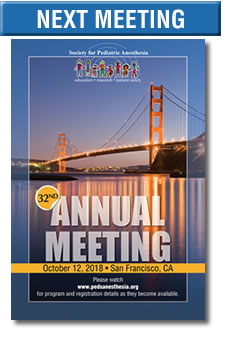Pediatric Anesthesiology 2018 Reviews
Friday Session III
A Tribute to Dr. Robert Friesen for the 2018 Robert M. Smith Award
Reviewed by Mark D. Twite, MB, BChir, FRCP
University of Colorado
Dr. Robert Friesen (1946 - ), who retired from clinical practice last year, has had a long, distinguished career as an academic pediatric anesthesiologist at the University of Colorado and Children’s Hospital of Colorado.
Dr. Robert Friesen undertook his undergraduate degree at Duke University, North Carolina and attended medical school at the University of Kansas. After graduating from medical school, Dr. Friesen started a surgical internship at the University of Colorado. Fortunately, one of his early rotations was in anesthesiology, as he quickly realized he was much more interested in the practice of anesthesia rather than surgery. After meeting with the Chairman of the Department of Anesthesiology, Dr. Peter Cohen, he was able to change tracks and start an anesthesia residency. During his pediatric anesthesia rotation, Dr. Friesen worked with Dr. Charlie Lockhart who fostered his interest in academic pediatric anesthesiology with an interest in cardiac anesthesiology. To gain further experience in the field of pediatric cardiac anesthesiology, Dr. Friesen organized a year of training abroad in the United Kingdom at St. Thomas’ Hospital and Great Ormond Street Hospital. This resulted in his first peer reviewed publication with Dr. A. Clements on measuring individual responses to heparinization for cardiopulmonary bypass with the early use of activated clotting time(1). This year was also the start of a lifelong friendship with Dr. Ted Sumner, who later became the Editor-in-Chief of the journal Pediatric Anesthesia, and who would invite Friesen to join the editorial board, which he now chairs. After his year of training in London, Dr. Friesen returned to Colorado in 1976 to begin his career at the Children’s Hospital of Colorado. He was the fifth pediatric anesthesiologist in the department. These were the formative years for the specialty of pediatric anesthesia, and his research interests reflect the important clinical issues of the time.
In the 1970s and early 1980s, Halothane was the only choice for inhaled induction of anesthesia in infants and children. Animal research demonstrated that the cardiovascular depression associated with halothane was more severe in newborn animals than older ones, presumably because the immature myocardium was more sensitive to depression(2-4). Rackow and Salanitre showed the increased incidence of cardiac arrest in infants undergoing general anesthesia, contributing to the mounting evidence that cardiovascular depression by halothane was more severe in human infants(5). In a prospective study, Dr. Friesen demonstrated for the first time that at equipotent doses of halothane, blood pressure depression was greater in neonates and infants less than 6 months of age than in older children(6). Additional prospective studies of halothane induction of anesthesia in infants documented a mean decrease in blood pressure of 50% that could be attenuated by pretreatment with atropine to maintain heart rate (7). A similar study of isoflurane followed, in which similar hemodynamic changes were observed and a high incidence of airway irritability and laryngospasm that precluded isoflurane from being a suitable inhalation induction agent (8). In further studies, Dr. Friesen demonstrated that hypotension associated with halothane use in infants could be attenuated with pretreatment of oral atropine and was exacerbated by prolonged preoperative fasting (9, 10).
Much of this early research work was made possible with the introduction of improved monitoring. When Dr. Friesen started out, the only vital signs commonly monitored by pediatric anesthesiologists were temperature, ECG and heart tones using a precordial stethoscope. Experienced practitioners could listen to changes in heart tones during the induction of anesthesia with halothane, and titrate the amount of halothane to avoid cardiac arrest. Measuring blood pressure at that time was done manually, with a blood pressure cuff and stethoscope, listening for changes in Korotkoff sounds. While this worked in older children, it was very difficult to do in infants. Instead a Doppler probe was used, typically over the brachial or radial arteries, to listen for blood pressure changes during cuff inflation. In the late 1970s, Dr. Maynard Ramsey, introduced the "Dinamap", an acronym for Device for Indirect Non-invasive Mean Arterial Pressure, the first automated system to non-invasively measure blood pressure using an oscillometric method (11). Quick to realize the importance of this monitor in pediatric anesthesia, Dr. Friesen, working with one of his trainees, Lance Lichtor, conducted perhaps the first non-industry sponsored study of the Dinamap, demonstrating that its measurements were accurate in neonates and infants (12).
As with the Dinamap, another new monitor came along and captured his attention. This was the Ladd Steritek Intracranial Pressure monitor, a non-invasive monitor of intracranial pressure for neonates with open fontanelles. The halothane anesthetic techniques at the time often resulted in large changes in blood pressure and intraventricular hemorrhage. Working with Rita Thieme, a neonatal nurse practitioner, Dr. Friesen conducted a series of studies on the changes in anterior fontanelle pressure with different anesthetic agents, during cardiopulmonary bypass and hypothermic circulatory arrest, but perhaps the most important of these studies demonstrated a 200% increase in intracranial pressure during awake tracheal intubation of preterm neonates (13-16). This latter finding has changed the way neonates are intubated in the operating room, with most anesthetized, but has been slower to catch on in many neonatal intensive care units.
Many of these research studies on halothane and new monitoring technologies in neonates took place in the cardiac operating room. Dr. Friesen continued to research pertinent clinical questions in the field of congenital cardiac anesthesia. Due to the problems associated with halothane anesthesia, synthetic opioids were widely used as they had minimal hemodynamic effects, even at high doses (17). Yaster and colleagues conducted research that defined the anesthetic doses of fentanyl in neonates (18). Dr. Friesen worked with his anesthesia colleague, Desmond Henry, to confirm the lack of significant cardiovascular side effects in studies using fentanyl as the sole anesthetic agent in neonates (19). Further work with an anesthesia trainee, Jim Glenski, demonstrated the safety of high doses of fentanyl and sufentanil as anesthetics for pediatric cardiac anesthesia and another trainee, Raphael Campanini, studied the use of remifentail for fast track cardiac anesthesia (20, 21). One of problems faced in the cardiac operating room is the coagulopathy associated with cardiopulmonary bypass. Before the advent of ‘miniaturized’ heparin coated bypass circuits, neonates were placed on cardiopulmonary bypass using large volume cardiopulmonary bypass circuits resulting in a dilutional coagulopathy. Dr. Friesen studied techniques to reduce this and demonstrated that both modified ultrafiltration and the infusion of fresh autologous whole blood led to significantly improved coagulation status following cardiopulmonary bypass (22, 23). A monitor which entered clinical practice much later in his career was Near Infrared Spectroscopy (NIRS). While it was initially employed to monitor cerebral saturations in patients undergoing cardiopulmonary bypass surgery, he recognized its use to monitor the gut in neonates with complex congenital heart disease who have an increased morbidity from gut ischemia. Working with a critical care trainee, Jon Kaufman, they determined that monitoring splanchnic regional oxygen saturation with a NIRS sensor placed over the anterior abdomen was an accurate monitor of gut perfusion and oxygenation and was superior to a sensor placed in the dorsolateral position for that purpose (24).
Dr. Friesen has always had the delivery of excellent clinical care to pediatric patients as a central theme to his research. When new monitoring technologies were introduced, usually for the adult population, he wanted to see how these new technologies could be applied to children and what new things pediatric anesthesiologists could learn. When the bispectral index monitor of hypnotic depth was introduced (BISTM Medtronic, Minneapolis, MN), he validated its use as a sedation monitor by finding good correlation with validated sedation scores and then demonstrated that procedural sedation by non-anesthesiologists often attained the depth of general anesthesia (25-27).
The University of Colorado, located in the mile-high city of Denver, is well known for its pulmonary hypertension research and patient population with the disease. During his career, Dr. Friesen has worked with cardiology colleagues to care for numerous pediatric patients with pulmonary hypertension. Many studies have demonstrated the increased risk of perioperative mortality in patients with pulmonary hypertension (28). He conducted one of the first studies that documented the high risk of cardiac arrest in children with pulmonary hypertension undergoing non-cardiac procedures (29). He also studied the potential for respiratory depression during both preoperative and procedural sedation in cardiac patients and raised the concern that this could cause an increase in pulmonary vascular resistance in patients with pulmonary hypertension (30, 31). In addition, Friesen studied the pulmonary hemodynamic effects of a newer anesthetic drug, dexmedetomidine, and a controversial older anesthetic drug, ketamine, in children with and without pulmonary hypertension, and concluded that both drugs could be safely used (32, 33).
One of the keys to success in his research career has been asking the right questions. He identifies an important clinical problem and then formulates a study to help answer it. Along his career path, Dr. Friesen has shared his passion for the anesthesia care of patients and wisdom in conducting research. Many of his research projects have been conducted with trainees and students, who have co-authored more than half of his peer reviewed papers. In addition, he has mentored many fellows who have earned trainee research awards for studies conducted under his guidance.
Pediatric anesthesia began to emerge as a subspecialty in the 1960s. Herbert Rackow and Ernest Salanitre, both academic anesthesiologists at Columbia University, made significant contributions to developing the specialty. They were charter members of the Section on Anesthesiology of the American Academy of Pediatrics (AAP), founded in 1965, with Rackow being the section’s first chair. At the annual meeting of the Section in April 1990, Dr. Friesen as the program chair having earlier nominated these two pioneers in pediatric anesthesia for the Robert M. Smith award, had the honor of presenting it to both (34).
The Congenital Cardiac Anesthesia Society (CCAS) was founded as an affiliate section of the Society for Pediatric Anesthesia (SPA) in 2005. Dr. Friesen has been actively involved with CCAS by speaking and moderating sessions at the Annual Meeting and serving on the board of directors. Realizing the importance of active participation in anesthesia societies, he has also served as the president and program director for the Colorado Society of Anesthesiologists.
AAP, SPA and CCAS are forging alliances across the world to foster friendships and research collaborations among pediatric anesthesiologists to improve the anesthetic care of children. In 2015, in Aberdeen, Scotland at the joint meetings of the Society for Pediatric Anesthesia and the Association of Paediatric Anaesthetists of Great Britain and Ireland (APA), and their respective component societies, the Congenital Cardiac Anesthesia Society and the Congenital Cardiac Anesthesia Network, Dr. Robert Friesen was recognized for his outstanding contributions to the field of pediatric anesthesia with Honorary Membership of the APA. It is therefore very timely that Dr. Robert Friesen received one of the highest tributes in pediatric anesthesia from the AAP at this year’s Annual Meeting of the SPA in Phoenix, AZ, the 2018 Dr. Robert M. Smith Award. Congratulations!
References
- Friesen RH, Clement AJ. Individual responses to heparinization for extracorporeal circulation. J Thorac Cardiovasc Surg. 1976;72(6):875-9.
- Cook DR, Brandom BW, Shiu G, Wolfson B. The inspired median effective dose, brain concentration at anesthesia, and cardiovascular index for halothane in young rats. Anesth Analg. 1981;60(4):182-5.
- Rao CC, Boyer MS, Krishna G, Paradise RR. Increased sensitivity of the isometric contraction of the neonatal isolated rat atria to halothane, isoflurane, and enflurane. Anesthesiology. 1986;64(1):13-8.
- Krane EJ, Su JY. Comparison of the effects of halothane on newborn and adult rabbit myocardium. Anesth Analg. 1987;66(12):1240-4.
- Rackow H, Salanitre E, Green LT. Frequency of cardiac arrest associated with anesthesia in infants and children. Pediatrics. 1961;28:697-704.
- Friesen RH, Wurl JL, Charlton GA. Haemodynamic depression by halothane is age-related in paediatric patients. Pae diatr Anaesth. 2000;10(3):267-72.
- Friesen RH, Lichtor JL. Cardiovascular depression during halothane anesthesia in infants: study of three induction techniques. Anesth Analg. 1982;61(1):42-5.
- Friesen RH, Lichtor JL. Cardiovascular effects of inhalation induction with isoflurane in infants. Anesth Analg. 1983;62(4):411-4.
- Miller BR, Friesen RH. Oral atropine premedication in infants attenuates cardiovascular depression during halothane anesthesia. Anesth Analg. 1988;67(2):180-5.
- Friesen RH, Wurl JL, Friesen RM. Duration of preoperative fast correlates with arterial blood pressure response to halothane in infants. Anesth Analg. 2002;95(6):1572-6, table of contents.
- Glasser SP, Ramsey MR, 3rd. An automated system for blood pressure determination during exercise. Circulation. 1981;63(2):348-53.
- Friesen RH, Lichtor JL. Indirect measurement of blood pressure in neonates and infants utilizing an automatic noninvasive oscillometric monitor. Anesth Analg. 1981;60(10):742-5.
- Friesen RH, Honda AT, Thieme RE. Perianesthetic intracranial hemorrhage in preterm neonates. Anesthesiology. 1987;67(5):814-6.
- Friesen RH, Honda AT, Thieme RE. Changes in anterior fontanel pressure in preterm neonates during tracheal intubation. Anesth Analg. 1987;66(9):874-8.
- Friesen RH, Thieme R. Changes in anterior fontanel pressure during cardiopulmonary bypass and hypothermic circulatory arrest in infants. Anesth Analg. 1987;66(1):94-6.
- Friesen RH, Thieme RE, Honda AT, Morrison JE, Jr. Changes in anterior fontanel pressure in preterm neonates receiving isoflurane, halothane, fentanyl, or ketamine. Anesth Analg. 1987;66(5):431-4.
- Hickey PR, Hansen DD, Wessel DL, Lang P, Jonas RA. Pulmonary and systemic hemodynamic responses to fentanyl in infants. Anesth Analg. 1985;64(5):483-6.
- Yaster M. The dose response of fentanyl in neonatal anesthesia. Anesthesiology. 1987;66(3):433-5.
- Friesen RH, Henry DB. Cardiovascular changes in preterm neonates receiving isoflurane, halothane, fentanyl, and ketamine. Anesthesiology. 1986;64(2):238-42.
- Glenski JA, Friesen RH, Hassanein RS, Henry DB. Comparison of the hemodynamic and echocardiographic effects of sufentanil, fentanyl, isoflurane, and halothane for pediatric cardiovascular surgery. J Cardiothorac Anesth. 1988;2(2):147-55.
- Friesen RH, Veit AS, Archibald DJ, Campanini RS. A comparison of remifentanil and fentanyl for fast track paediatric cardiac anaesthesia. Paediatr Anaesth. 2003;13(2):122-5.
- Friesen RH, Campbell DN, Clarke DR, Tornabene MA. Modified ultrafiltration attenuates dilutional coagulopathy in pediatric open heart operations. Ann Thorac Surg. 1997;64(6):1787-9.
- Friesen RH, Perryman KM, Weigers KR, Mitchell MB, Friesen RM. A trial of fresh autologous whole blood to treat dilutional coagulopathy following cardiopulmonary bypass in infants. Paediatr Anaesth. 2006;16(4):429-35.
- Kaufman J, Almodovar MC, Zuk J, Friesen RH. Correlation of abdominal site near-infrared spectroscopy with gastric tonometry in infants following surgery for congenital heart disease. Pediatr Crit Care Med. 2008;9(1):62-8.
- McDermott NB, VanSickle T, Motas D, Friesen RH. Validation of the bispectral index monitor during conscious and deep sedation in children. Anesth Analg. 2003;97(1):39-43, table of contents.
- Motas D, McDermott NB, VanSickle T, Friesen RH. Depth of consciousness and deep sedation attained in children as administered by nonanaesthesiologists in a children's hospital. Paediatr Anaesth. 2004;14(3):256-60.
- Twite MD, Zuk J, Gralla J, Friesen RH. Correlation of the Bispectral Index Monitor with the COMFORT scale in the pediatric intensive care unit. Pediatr Crit Care Med. 2005;6(6):648-53; quiz 54.
- Odegard KC, DiNardo JA, Kussman BD, Shukla A, Harrington J, Casta A, et al. The frequency of anesthesia-related cardiac arrests in patients with congenital heart disease undergoing cardiac surgery. Anesth Analg. 2007;105(2):335-43.
- Carmosino MJ, Friesen RH, Doran A, Ivy DD. Perioperative complications in children with pulmonary hypertension undergoing noncardiac surgery or cardiac catheterization. Anesth Analg. 2007;104(3):521-7.
- Alswang M, Friesen RH, Bangert P. Effect of preanesthetic medication on carbon dioxide tension in children with congenital heart disease. J Cardiothorac Vasc Anesth. 1994;8(4):415-9.
- Friesen RH, Alswang M. Changes in carbon dioxide tension and oxygen saturation during deep sedation for paediatric cardiac catheterization. Paediatr Anaesth. 1996;6(1):15-20.
- Friesen RH, Nichols CS, Twite MD, Cardwell KA, Pan Z, Pietra B, et al. The hemodynamic response to dexmedetomidine loading dose in children with and without pulmonary hypertension. Anesth Analg. 2013;117(4):953-9.
- Friesen RH, Twite MD, Nichols CS, Cardwell KA, Pan Z, Darst JR, et al. Hemodynamic response to ketamine in children with pulmonary hypertension. Paediatr Anaesth. 2016;26(1):102-8.
- Friesen RH. Herbert Rackow and Ernest Salanitre: the emergence of pediatric anesthesia as a specialty in the United States. Paediatr Anaesth. 2015;25(7):663-7.






